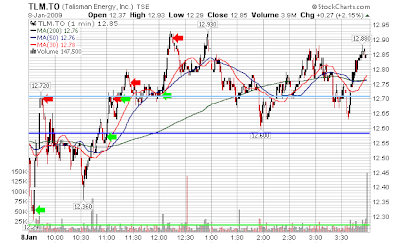ETFs are what they are, an Exchange Traded Fund so their basic price follows the related fund closely with some variance in the actual purchase and sale price due to the auction style of trading, just like a stock in that regard...there is a spread between the bids and asks. Enough about that.
HGU - Horizons Betapro Global Gold Bull Plus Fund
HGD - Horizons Betapro Global Gold Bearl Plus Fund
SPTGD - TSX Global Gold Index
AEM - Agnico-Eagle Mines, a stock for some reference as I am familiar with it and it tends to lead the index slightly.
I will only chart HGU for today's trading (fake)
0934h Buy $11.23 Sell $12.00 Gain 77 cents ps Return 6.9%
1009h Buy $12.07 Sell $12.30 Gain 23 cents ps Return 1.9%
1030h Buy $12.31 Sell $12.50 Gain 19 cents ps Return 1.5%
1105h Buy $12.31 Sell $12.51 Gain 20 cents ps Return 1.6%
1154h Buy $12.32 Sell $12.44 Gain 12 cents ps Return 1.0%
1258h Buy $12.62 Sell $12.89 Gain 27 cents ps Return 2.1%
$ 1.78 gain per share or 15% overall return on trades
That translates into $474 virtual dollars profit or 11.9% return on portfolio.
The slightly longer story:
The main reason that I did not actually trade these today was due to the fact that I slept in, health issue and missed alarm, I think I did not wset it properly. I ended up with 10 minutes to do my chart setups for a whole new bunch of stocks and funds. So I saw the first trade setup and just did not have all my ducks in a row.
I followed some pretty hard and fast rules for these trades though once I got them going. Being a newish trading setup I decided, after missing that first large move, that I was asking for trouble trying to make some real money today.
Entries were based on limit orders set 2 cents higher than the pivot point being tested. I could also use market orders to be sure of a full fill each time but I will keep to limit orders to reduce the possible jumpy trade price filling me higher than I would like.
Exits were based on the next pivot target, following if momentum was good and exiting before targets if the buying weakened.
I did track a few trades for HGD, the bear version, but didn't count them as they were less than stellar, profitable but small and really were against the trend altogether, just for practise.
Jeff.











































